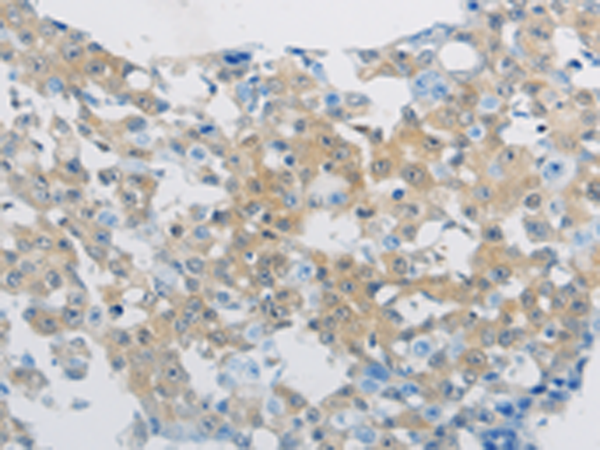
| WB | 咨询技术 | Human,Mouse,Rat |
| IF | 咨询技术 | Human,Mouse,Rat |
| IHC | 1/50-1/100 | Human,Mouse,Rat |
| ICC | 技术咨询 | Human,Mouse,Rat |
| FCM | 咨询技术 | Human,Mouse,Rat |
| Elisa | 1/2000-1/10000 | Human,Mouse,Rat |
| Aliases | DLEC, HECL, BDCA2, CD303, CLECSF7, CLECSF11, PRO34150 |
| Host/Isotype | Rabbit IgG |
| Antibody Type | Primary antibody |
| Storage | Store at 4°C short term. Aliquot and store at -20°C long term. Avoid freeze/thaw cycles. |
| Species Reactivity | Human |
| Immunogen | Synthetic peptide of human CLEC4C |
| Formulation | Purified antibody in PBS with 0.05% sodium azide and 50% glycerol. |
+ +
以下是关于CLEC4C抗体的3篇参考文献及其摘要概括:
---
1. **文献名称**: *BDCA-2. a Novel Plasmacytoid Dendritic Cell-Specific Type II C-Type Lectin, Mediates Antigen Capture and Is a Potent Inhibitor of Interferon α/β Induction*
**作者**: Dzionek, A., et al.
**摘要**: 该研究首次鉴定了BDCA-2(CLEC4C)作为浆细胞样树突状细胞(pDC)的特异性标记物,并开发了针对BDCA-2的单克隆抗体。实验表明,抗体结合BDCA-2可显著抑制pDC在病毒感染后产生I型干扰素的能力,提示其在调节抗病毒免疫反应中的潜在作用。
2. **文献名称**: *Structural Basis for CLEC4C (BDCA-2) Antibody Recognition and Viral Immune Evasion*
**作者**: Santha, S., et al.
**摘要**: 本研究解析了CLEC4C的晶体结构,揭示了其与抗体的结合表位。通过功能实验发现,特定抗体可阻断CLEC4C与病毒糖蛋白(如HIV的gp120)的相互作用,为基于抗体的抗病毒治疗策略提供了结构基础。
3. **文献名称**: *Targeting CLEC4C in Lupus Models: Antibody-Mediated Suppression of Autoimmunity*
**作者**: Blanco, P., et al.
**摘要**: 研究在小鼠系统性红斑狼疮(SLE)模型中测试了抗CLEC4C抗体的治疗效果。结果显示,抗体通过抑制pDC的异常活化,减少自身抗体产生和炎症损伤,表明CLEC4C抗体在自身免疫疾病中的治疗潜力。
---
以上文献涵盖了CLEC4C抗体的基础功能、结构机制及治疗应用,均为该领域的代表性研究。如需具体文献来源,可进一步通过PubMed或期刊数据库检索作者及标题获取全文。
CLEC4C (C-type lectin domain family 4 member C), also known as BDCA-2 or CD303. is a cell surface receptor predominantly expressed on plasmacytoid dendritic cells (pDCs), a specialized subset of dendritic cells critical in antiviral immunity and autoimmune regulation. As a member of the C-type lectin receptor family, CLEC4C recognizes pathogen- or damage-associated carbohydrate patterns, such as high-mannose glycans on viral or tumor-derived proteins. It plays a dual role in immune responses: facilitating antigen internalization for processing/presentation and modulating pDC activation by transmitting inhibitory signals. Upon ligand binding, CLEC4C recruits the adaptor protein FcεRγ, triggering Syk kinase-dependent signaling pathways that suppress the production of type I interferons (IFNs) and proinflammatory cytokines. This regulatory mechanism helps prevent excessive inflammation but may also be exploited by pathogens to evade immune detection.
CLEC4C-targeting antibodies have emerged as valuable tools for both research and therapeutic applications. In research, anti-CLEC4C antibodies enable specific identification and isolation of pDCs via flow cytometry. Therapeutically, they are explored for autoimmune diseases (e.g., lupus) where aberrant IFN-α production by pDCs drives pathology. Antibody-mediated CLEC4C crosslinking can suppress pDC activation, offering a strategy to dampen harmful immune responses. Conversely, in cancer immunotherapy, CLEC4C antibodies may enhance antitumor immunity by blocking inhibitory signals or delivering cytotoxic payloads to pDCs. Challenges include optimizing antibody specificity and balancing immune modulation to avoid immunosuppression. Current studies focus on elucidating CLEC4C's ligand interactions and downstream signaling to refine antibody-based interventions.
×